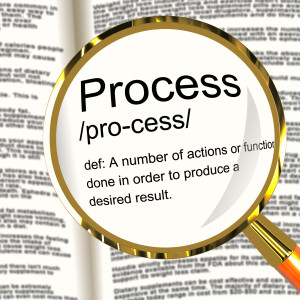 On board a Boeing 777, cruising at 37,000 feet over the Atlantic Ocean, in-flight between Chicago and London. A yellow light goes on indicating that there is a fire in the baggage compartment, which is not accessible by the crew. What should be done next? Relying just on training and experience is not enough. Airline flight crews depend on checklists (or mini process maps) to give them step-by-step instructions of the key factors necessary to handle this and hundreds more emergencies that could occur during a “routine” flight.
On board a Boeing 777, cruising at 37,000 feet over the Atlantic Ocean, in-flight between Chicago and London. A yellow light goes on indicating that there is a fire in the baggage compartment, which is not accessible by the crew. What should be done next? Relying just on training and experience is not enough. Airline flight crews depend on checklists (or mini process maps) to give them step-by-step instructions of the key factors necessary to handle this and hundreds more emergencies that could occur during a “routine” flight.
The result? Using checklists has allowed air transportation to consistently grow safer over the past several decades.
Jones, Lang, and LaSalle, a worldwide organization in property and construction management, does not rely on memory in the development and execution of project. The cost of errors in their industry could mount into the millions of dollars, and with that sort of potential, you cannot put that action to chance. So, they rely on a step-by-step set of process maps to guide the project manager from design to construction to post construction reconciliation. In addition, if there is clear documentation over each step executed, and the project manager is promoted, another project manager can come into the role and be up to speed in a matter of hours.
Advocate Good Samaritan Hospital near Chicago, Illinois, uses process maps to guide its surgical teams. A mistake in the process could mean a life. MidwayUSA, an online and mail-order retailer, uses 1500 separate process maps to guide its employees. As Larry Potterfield explained it, “If you want to have quality outcomes, you have to have a consistent process that leads to consistent behaviors.” Midway USA’s vision is “to be the best-run business in America for the benefits of it customers.”
We found as we developed our book, It’s My Company Too! (2013 Greenleaf), that some of the best-run organizations we studied have very specific process mapping and management. We focused our book on detailed case studies of eight exceptional organizations that were benchmarks of operational excellence, had superior employee engagement, and employed what we called entanglement, the next step beyond engagement.
A central part of the reasons why these organizations did so well related to having defined their key processes, and then working to manage those processes. In using processes, the organization developed high operational quality in meeting customer needs, while, at the same time, meeting employee needs.
How did that work?
The whole nature of process mapping is articulating each step of doing an activity. Quality award organizations, like the national Malcolm Baldrige organization, believe that the best organizations are those that define their key processes and then focus on managing those processes to better meet the needs of customers, and, at the same, strive toward driving down costs.
Measures are used to assess performance of the process including the speed of the process, reliability (number of errors in the process), cost of the process, the capacity of the process, and, if the process interacts with customers, how satisfied the customers are with the process.
Process performance is then aligned to the goals of the organization. Thompson and Mathys (Organizational Dynamics, 2008) suggest that a matrix be created that would align measures like specific customer requirements (for example, fast service or error-free service) to process performance measures. Improvements in the process performance should correlate with customer satisfaction. This can be done with financial outcomes as well. For example, reducing process costs for the key processes of the organization will support improving profits. The alignment of measures helps to keep the focus on why process performance levels are important to the desired outcomes of the organization. This helps organization leadership to keep a focus on that which best meets desired organization outcomes and keeps the focus of the workforce on knowing what is important in their job.
How does this help employee engagement?
A clear, well-defined process with measures of process performance helps to clarify what is important to the organization, and, therefore, what should be important to the employee. By clarifying the task, it helps to reduce the stress an employee has when their performance expectations are not clarified. In addition, if employees have input in improving the process, they will obtain greater ownership in that process and have greater confidence in their abilities.
In our book, Jack Stack, CEO of SRC corporation (chapter 1), talks about having each employee realize that their job is 70/30. Seventy percent of their time is on the specific assigned job, and thirty percent of their time is spent on improving the job and the rest of the organization. Their incentive system reflects the degree of commitment that employees should have, and it builds one exciting place to work.
So, having a solid set of processes helps to structure the organization and align performance with outcomes. Giving employees clarity of what needs to be done helps them do a good job, which builds confidence. Getting the employee involved in decision-making gives them ownership. All of which creates the culture for an engaged and entangled workforce.